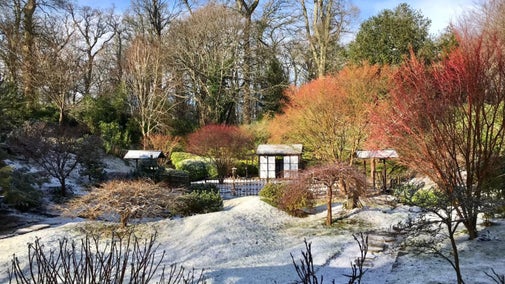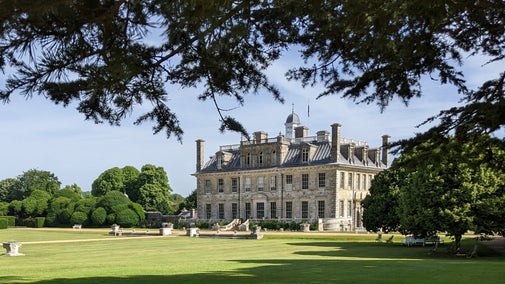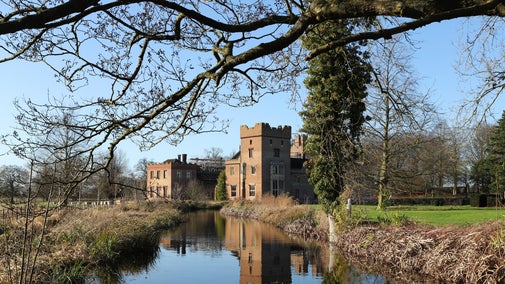
Discover more at Kingston Lacy
Find out when Kingston Lacy is open, how to get here, the things to see and do and more.

Here at the National Trust, our expert team at Kingston Lacy is dedicated to protecting the place and its natural surroundings for the benefit of future generations. From hedgerow planting aimed at preserving natural habitats and boosting biodiversity, through rediscovering carefully preserved textiles and installing a ground source heat pump, conservation is a vital part of what we do.
Two 19th century gowns worn by Henrietta Bankes, the mother of Henry John ‘Ralph’ Bankes who gifted the Kingston Lacy estate to the National Trust in 1981, are being carefully conserved and mounted so that the fragile textiles can go on display.
The gowns, which have been stored out of sight for more than a century, are wonderful examples of haute couture and the work of two of the most important 19th century fashion houses: Doucet and Paquin, whose premises were within doors of each other on the fashionable Rue de la Paix in Paris.
The first, a pale green satin evening gown trimmed with chiffon and ribbon, was made to measure by Jacques Doucet in 1896. The second is a cream chiffon, lace-trimmed tea gown with purple ribbons, and was made by the pioneering female couturier, Jeanne Paquin, who opened a store in London in 1896.
The textiles have maintained an astonishing richness of colour but needed protection against further deterioration. Weak areas were reinforced with transparent gauze, and creases and discolouration removed with very gentle steaming.
The work also revealed other details: on the Doucet, remnants of the silk threads that indicate an elaborate decorative trim (now missing); while the Paquin had additional panels to let out the dress to accommodate a changing shape.

Kingston Lacy's cupola is an iconic feature but its construction has caused a lot of problems over the years.
The cupola was added in 1835, designed by architect Charles Barry to be thinner and taller than the previous one and act simply as a impressive lantern to light the attic below. It was also glazed inside out, probably in order to look more attractive to guests being taken on a tour of the roof.
That glazing, which makes it easy for moisture to sit in the window frames, means the cupola needs regular maintenance. But the shape means access is very difficult, so we have commissioned a bespoke scaffolding tower to fit through a 1.8 metre diameter, 10 metre tube. We have also made protective boxing for the beautiful plaster mouldings when we are working on the glazing.
Now, conservation staff and volunteers can access the cupola safely to carry out more frequent maintenance.
Kingston Lacy is opulent, spectacular and astonishing. In 2023 this 'jewel box' mansion installed a 160kW ground source heat pump system to replace the ageing oil boilers, saving around 30,000 litres of oil and 57 tonnes of carbon a year.
The project is one of the National Trust’s biggest heat pump projects to date, and the first high temperature ground source system the charity has installed. It cut emissions to around a quarter of their current levels.
But it helps us in our conservation work as well. Using a green energy source means we are able to heat the mansion at a low temperature for longer periods. This improves the internal environment and humidity control of the collections, and helps us secure this beautiful place for the future.
In 2022, the Trust announced it had removed a million litres of oil from its properties since 2013, following a nine-year investment programme to “get off oil” and grow its own green energy supply. Another 100 renewable projects – including many heat pumps – are in the pipeline to further reduce fossil fuel use and help the charity reach its ambition of net zero by 2030.
This project was part funded by Low Carbon Dorset as part of the European Regional Development Fund.
Our habitat conservation work means we have a growing number of birds on the estate, with many endangered species breeding here. We are working with the RSPB to monitor birds at Badbury Rings and Bishops Court Farm; over time, this provides data that shows whether our work is successful, and helps us plan our conservation strategy.
In the past six years (2018-2023) at Badbury Rings we've seen whitethroat territories grow by 162%, blackcaps by 144%, corn buntings by 80% and skylarks by 66%. At Bishops Court Farm, skylark territories have doubled in the past three years (2021-2023), with stonechat territories up by 35%, sedge warblers up by 36% and chiffchaffs up by 28%.
Birds like quiet, undisturbed landscapes, and are easily frightened by walkers and dogs. We are increasing the density of scrub to provide them with safer places to nest, while deep, thick hedgerows provide food as well as habitat. We are working to ensure other users of our sites understand the impact of their activities on the wildlife around them.
Species-rich hedgerows are critical for wildlife, and we look after miles of hedgerow on the Kingston Lacy estate. Hedgerows provide food for insects, birds and small mammals, as well as shelter.
Over-management of hedgerows is the biggest problem for the species that live in this habitat. Annual cutting using a mechanical flail creates a species-poor hedgerow of little value to wildlife; it takes out species that could grow into hedgerow trees, which provide a more structured habitat. It can take off new growth, removing most of the flowers and berries as well as eggs from moths.
Good hedges are tall and broad, with herb-rich bottoms and wide margins on either side – something we are trying to achieve here at Kingston Lacy, not only in our parkland but also on the wider estate (including our tenanted farmland).
So we cut hedges every three years or more instead of annually, allowing the plants to produce more flowers and berries, which are vital food for butterflies, bees, birds and moths.
We also leave old dead wood from trees in the hedgerows, whereas before we turned it into created woodchip. Leaving the deadwood will provide very valuable habitats for large numbers of invertebrate species as well as creating micro habitats within the decaying wood.)
And we are filling gaps and establishing new hedgrows: in spring 2023 more than 500 metres of hedging was planted on the estate, with the whips protected by biodegradable cardboard tubing.

With your ongoing support, we're able to continue our vital conservation work. Thank you for helping to protect these special places.

Find out when Kingston Lacy is open, how to get here, the things to see and do and more.
Interested in seeing behind the scenes at Kingston Lacy? The BBC's second series of Hidden Treasures of the National Trust features Kingston Lacy in episode one. You can watch the six-part series every Friday at 9pm on BBC Two, starting from Friday 10 May. You can also catch up on any episodes you miss on BBC iPlayer.

Discover how we’re transforming the Kitchen Garden to its former glory with new flower and veg beds, restored glasshouses and a replanted apple archway.

Home Farm on the wider estate is home to the special Red Ruby Devon cows and rare breed Portland sheep. Find out why you’ll see them out on the Kingston Lacy estate.

Discover how Kingston Lacy is encouraging biodiverse, resilient habitats for nature, yet with opportunities for people to explore the landscape.
Relax and wander the gardens to enjoy seasonal interest at any time of year, with plenty of space for children to run, skip and play, and spaces to stop along the way.

Find out more about the Bankes family home. Discover art treasures and look at how a large home was used by the family and their visitors who came to stay.

A vision from Venice nestled in a pocket of Dorset. Read about Kingston Lacy’s most influential owner who made it the important place you see today.

We believe that nature, beauty and history are for everyone. That’s why we’re supporting wildlife, protecting historic sites and more. Find out about our work.
